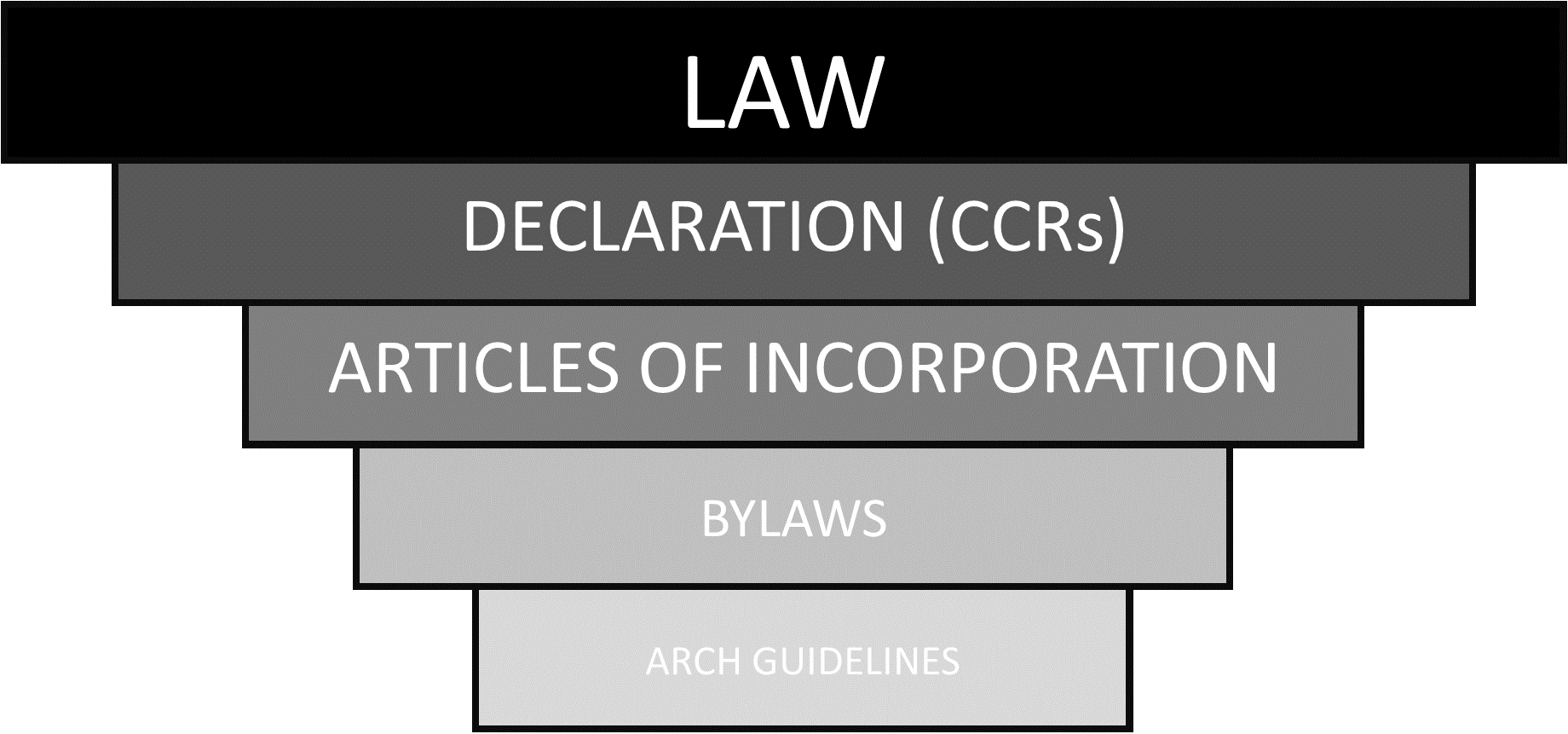
Governance & Rights
This section discusses the lawful hierarchy of governing documents, the origins of our homeowner rights, and the status of governing documents in Thaynes Canyon Subdivision.
Document Hierarchy
HOA governing documents are subject to a hierarchy dictated by law, with (1) federal and state code ranking above all organizational documents and (2) the founding documents, such as the Declaration and original Articles of Incorporation, trumping all supplemental docs.

A time of subdivision platting, a developer's Declaration and its lot restrictions, or "CCRs", comprise the cornerstone of the homeowner contract, and that document carries with the property deed. Concurrent Articles of Incorporation define the homeowners association (or "HOA") and its intended governance.
Supplemental documents, such as Bylaws, may be adopted, but only with due process and according to law. However, subordinate documents may never circumvent those ranking above. So, for example, newly adopted Bylaws, even if ratified by homeowners, may not alter the founding documents' original contract. The only way to alter the original contract is to duly amend the Declaration.
Founding Documents of Thaynes Canyon Subdivision
Upon platting Thaynes Canyon in 1971, the developer recorded a Declaration (1971) with three fundamental elements:
-
A set of covenants, conditions, and restrictions (known as “CCRs”) -- including, for example, 10’ setbacks, 25’ height max, and other architectural requirements.
-
An association named “Thaynes Canyon HOA”, concurrently incorporated as a nonprofit entity under Articles of Incorporation (1971) – a document that both (1) emphasizes democratic tenets, such as an elected board, and (2) specifies the HOA is defunct once dissolved according to law;
-
An architectural committee set within that HOA structure, selected by and accountable to homeowners and their elected board, funded with $50 review fees paid by applicants.
Thaynes founding documents include only the Declaration and original Articles of Incorporation. Neither document mentions any fee assessment – and this is logical, as our community has no facilities or maintenance that might incur common expense. The founder clearly intends a minimalist association, one equipped to simply and efficiently govern the buildout of a new community. This is our original homeowner contract – and as homeowners have never voted to amend, that contract still stands today.
Homeowner Rights
From these founding documents arise our homeowner rights -- fundamental conditions unalterable unless homeowners duly amend. Because owners have never amended the 1971 Declaration, all the rights and obligations stipulated in our founding documents remain intact, including but not limited to:
-
10’ setbacks, 25’ height max, and all other lot restrictions (CCRs/Declaration 6.4-6.5);
-
Right to pursue private legal action in defense of those restrictions (7.1)
-
Right to an association that is protected by nonprofit incorporation (3.1);
-
Right to democratic governance (4.1, 8.2, 1971 Articles VI.), including any decision to reconstitute an HOA, the election of any board, and authority over a subordinate architectural committee; and
-
With due process and the approval of homeowners, the right to amend that original contract (3.2, 8.2) to make it whatever we, collectively, want.
These rights exist independently of any association or and architectural review "committee". They are inherent in our founding contract and are not altered by any subordinate document, by any improper entity formation, or by any individual or group's claim of power. The only way these rights change is if we collectively change them.
Status of Thaynes Canyon Governing Documents
Each document and provision below were at some point argued to "govern" Thaynes homeowners. Current status is noted for each. (All documents are posted as downloadable, printable pdfs under File Share.)
* The Declaration mandates membership in, specifically, Thaynes Canyon HOA, which was dissolved according to law in 1986.
Too complicated?
Want to decisively remove these?


